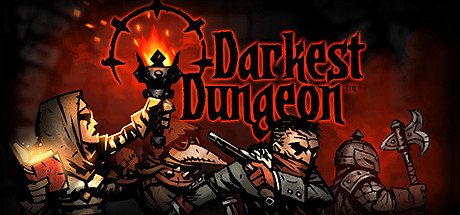
WHAT IT’S ABOUT.
DUNGEONS. And how dark they can be.
GOOD START.
Thanks.
Set your phasers to dark’n’grimy medieval fantasy mode, and you’ll be on track. In short, a relative of your unnamed character has accidentally opened up several portals to dark dimensions whilst carrying out excavations near the family manor. Unsurprisingly, monsters have sprung forth, and as your ancestor has deliberately buggered off to the big dungeon in the sky, it falls to you to fix things.
Your job is to cleanse the land of the foul beasts that have sprung forth around the manor’s location of Hamlet, so naturally, you send groups of four adventurers to particularly dark and dank dungeons in hopes of finding trinkets, money and taking down some nasty bosses.
WHAT YOU DO.
Gameplay is split into two parts; there’s the actual dungeon crawling, which is all about side-scrolling through various rooms, battling monsters and picking stuff up through procedurally-generated maps. Combat is turn-based, and available character types are nicely varied (lepers, hound masters and shape-shifting abominations are all on offer, to name but a few).The biggest difference here is that almost every decision you make is laced with risk, because developer Red Hook are a bunch of sadistic geniuses.
Alongside the health bar, you possess a stress metre, which can increase in an alarming number of ways. Enemies have abilities designed to target it, and even when they simply attack normally, a particularly devastating hit can subsequently spook your party members. Not even being outside of combat is a relief, as characters can become stressed by their comrades saying something catty about their walking speed, or just by interacting with one of many objects strewn around these dungeons. It’s basically a Parent’s Worst Nightmare simulator at this stage; you WILL cut yourself on that random piece of coral, you WILL contract a disease from messing around with that corpse and don’t you come crying to me if you open up that vestibule and see something of unspeakable horror.

When exploring, the trick is not to push your heroes too far. Eating brings a little of your HP back, but you’ll need to ration supplies for when your characters get hungry, and if you’ve run out of food, their health will bear the brunt. Using torches to brighten your path means less stress and darkness for your characters to manage, but if you don’t ration them carefully then combat will get harder once the lights go out. You can’t use spells, healing or otherwise, outside of battle but reinforcements will arrive if you draw out the slaying of one last enemy just to heal your party members that little bit extra. It’s all about weighing up risk and reward throughout your playthrough; I’ve seen several characters at decent levels fall from heart attacks after deciding I could afford to poke around a few more rooms after completing a quest, and once they’re dead, that’s it. You go back to Hamlet and pick up another one.
Hamlet offers the other half of the gameplay. This is where you level up your characters abilities, relieve their stress in the local tavern or church, depending on their fancies and upgrade these establishments to offer the best possible (and cheapest) support for your party. Your characters often won’t be able to manage two crawls in a row, and will need to recover after each quest with a bit of booze, prayer, nice bit of flagellation or just a good ol’ fashioned prostitute. So, you return from a dungeon, do a spot of shopping, drop your stressed or diseased characters off like you’re in the middle of some kind of medieval school run, and do the whole thing again. Bonzer!
SOUNDS HARD.
Maybe a bit, but it’s enjoyable. Crucially, despite the frequently nasty tone, things never get too heavy. Sure, you can change your characters names and the colour of their attire, but you’re never going to get too attached to your party members to the extent where you mourn their loss for days to come. Think of them more like slightly more fleshed-out Lemmings; they’re there to help you, and they might die, and that might be a bit sad for a second or two, but you’ve always got more in reserve.

WHY IT’S GOOD.
The whole process is pretty addictive. There’s a nice contrast between the instantly familiar gratification you get from slowly upgrading the town’s various buildings with the sense of tangible achievement you get from dragging four heroes through an arduous quest when they’re HP sits at 0, and they’re literally at death’s door. Being in Hamlet, even if you are just moving your cursor over each location, is nicely offset by the stresses that your crawls frequently bring, and despite the bleakness of it all, Darkest Dungeon’s hand-drawn art style and the sheer fun of what you’re doing makes sure the experience doesn’t turn into a sadistic trawl, like some other games which feature the work DARK in the title.
IN SHORT.
Grimy dungeon-crawling management game strikes gold.
Darkest Dungeon is available on PC, PlayStation 4 and PlayStation Vita. I played the Vita version because I refuse to admit defeat.
